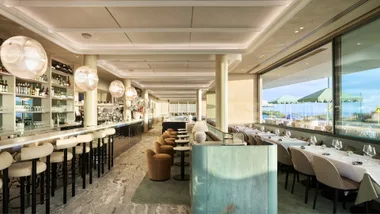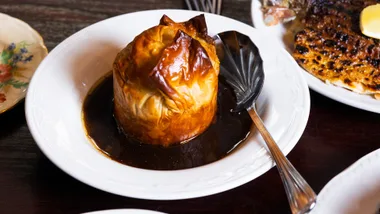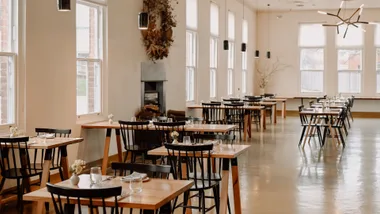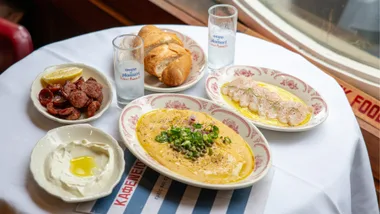23-33 Mary St, Surry Hills, (02) 8204 0800
Licensed
Cards AE MC V EFT
Open Lunch Fri noon-3pm; dinner Tue-Sat 5.30pm-10.30pm
Prices Entrées $18-$23, main courses $22-$96, desserts $16-$17
Vegetarian Two entrées
Noise Noisy but not deafening
Wheelchair access Yes
Minus Not inexpensive
Plus Unique food, worth every penny
Gather near, children, and let me tell you of a time way back in the past when menus were just a list of the dishes on offer, possibly with the prices next to them. That was before the era of bills of fare loaded up with more credits than a Pixar movie (was the International in Darlinghurst in the ’90s the first place to name-check the waiters’ tie-bars?), back when “chef’s philosophy” were two words floating free of each other in the ether, a gentle and innocent time when a mission statement wasn’t something you’d expect to find in your dinner. (And let’s not even get into, “Have you dined with us before?”, the hospitality equivalent of a wet-fish handshake.) Those were the days.
Anyway, at Firedoor they don’t muck around with any of that rot mercifully, but they have given the back of the menu over to a short dissertation on the 11 woods they burn in their kitchen. It’s bracingly straight stuff for the most part: pecan is hard, burns hot and has a strong and distinctive sweet flavour. Grapevine shoots are ideal for fast fires to quickly cook smaller cuts of meat, while orange burns with a perfume that combines well with the richness of salmon or mussels. The description for hay (“though not a wood”) details the fragrant qualities of coumarin, “a phytochemical with a vanilla-like flavour that naturally occurs in lavender, liquorice, strawberries, apricots, cherries, cinnamon and sweet clover”, before going on to note that hay combusts readily and offers a taste that is a fine match for mackerel, sweetbreads and snails.
For the most part this isn’t the sort of information you crib from a book or the internet. Or at least Lennox Hastie didn’t. This is knowledge he picked up and refined working over the coals for years at Asador Etxebarri, the fêted restaurant outside Bilbao in the Basque country that has over the past decade come to be a place of pilgrimage for anyone interested in the art of cooking with fire.
Hastie appears to really like doing things the hard way. Nothing about the axe hanging on the wall or the bandsaw behind the open kitchen’s counter suggests he’s interested in shortcuts, and everything about the meticulous way he moves around the grills, carefully raising and lowering them on pulleys, keeping the coals just so, suggests a chef in control. A chef in his element.
There’s no gas line at Firedoor, his new Surry Hills restaurant, and anything that’s cooked is cooked over coals. While the smoke in the air might put diners in mind of the burnt-onion-and-exploding-snag fun of the backyard barbie, there’s nothing slapdash about this operation, and you get the impression that questions about beer-can chicken might lead all too quickly to an encounter with the axe and the bandsaw. Hastie’s cooking is like nothing else in town.
While seafood of all stripes is a focus and vegetables get the rock-star treatment here, Firedoor may well make its reputation by redefining how a steak can and should be cooked. Hastie starts with O’Connor grass-fed Angus-Hereford cross, which he slices off the rack of ribs to order with said bandsaw. The meat has been dry-aged for a very long time. Our resident meat guru Anthony Puharich (who supplies Firedoor) says 30 or 40 days is usually considered the sweet spot, where the complexity of the meat’s flavour is well developed but the loss from dehydration and trim isn’t too great. Hastie’s beef has been hanging for 150 days, which goes some of the way to explaining why it was originally listed on the menu at “market price” (read: if you have to ask, you won’t want to know).
Spend the money. They’ve put a price on it now; the last one I ordered was $96 for half a kilo. The meat comes out nude on the plate, sliced, with the bone to the side. No one asks you how you want it cooked, but it ticks the boxes that every steak lover, from the well-done die-hards to the carve-off-a-chunk-and-I’ll-ride-the-rest-home crowd, wants ticked: the absence of dryness, the presence of rich and complex flavour and texture. The steak isn’t much more than a centimetre thick but it’s juicy and densely flavoursome. The dark caramelisation on the outside is the thing that even our most vaunted steak specialists seldom nail. It’s a bit like the great pâtissiers cooking caramel right to the very edge but stopping before it actually burns. There’s no hint of the burnt or bitter here; just maximum beef, with more than a hint of gaminess from the dry-ageing.
Back at the other end of the menu, the bonito is barely cooked. Oily fish like this taste great with a bit of blackening on the grill, so it’s interesting to see that Hastie hardly colours it. The slivers are more warmed in smoke in pans made of mesh than grilled in the traditional sense, then laid, fatty and pink, in a nest of pea flowers and pomelo. The smoke factor steps up with thick strips of bullhorn peppers, roasted to sweet softness over the grill, lolling on the plate red and happy with smoked Jersey milk curd and a tangle of red elk leaves. Hastie does vegetables with flair, grilling salad leaves (cos and treviso among them) enough to intensify their flavour without compromising their texture, tossing them together with hunks of pecan, and guanciale cut into fine and melting ribbons.
Firedoor doesn’t go in much for decorative flourishes, and Hastie did much of the design and build himself, but it’s not a no-frills establishment by any stretch. The slightly sunken aspect of the room, on a Surry Hills side-street, is appealing. There’s plenty of timber in the room, fittingly, while the food comes out on attractively earthy stoneware. The luxury is in the details, whether it’s the alarmingly sharp and heavy knives, designed by Hastie and handmade at Tharwa Valley Forge in the ACT, that come out with the steak, or the nutty, smoky bread baked here and proffered with a choice of smoked house-churned butter and oil from picual olives grown in Mudgee, “pressed three Wednesdays ago”, according to restaurant manager Charles Casben.
Casben delivers the sort of service you’ll get on a good day at Firedoor – thoroughly informed, professional in an unstuffy way, and able to pick up the ball and run with it. He offers the line about the oil with enough humour to say, “Yes, I know, this is a slightly ridiculous level of detail,” but with enough commitment to make it seem worthwhile. When there are slips from his colleagues (the occasional note of intrusiveness or odd timing, say) it’s usually more a matter of overeagerness than anything else.
They certainly know what they’re pouring. The list, compiled by Master of Wine Ned Goodwin, trips lightly from great Sherries through a by-the-glass offering that shows off the “thread of smoky, mineral freshness” that guided many of Goodwin’s choices. Casben pulls out a Latta sav blanc from Gisborne and a Fall from Grace arneis from McLaren Vale to pair with several of the first courses, mostly fish and vegetables. Both wines have seen some time on skins, and the rich sweet fat of the bonito, for one, finds plenty to play with in their grippy complexity.
Though it’s home to a steak against which all others in the country may be judged – not to mention dry-aged lamb rump cap that, paired with cavolo nero and creamy borlotti beans, could be a benchmark for how to cook sheep properly – Firedoor is really all about the fruits of the sea. Hastie has spent years in a part of the world that is profoundly obsessed by seafood, which hasn’t hurt his grasp of its essentials.
There’s nothing radical about the combination of pipis, chilli and garlic.
It’s the meticulous execution that makes it sing, the shellfish full of juice but free of grit, the garlic and chilli sliced into translucent wafers that melt into the sauce, keeping the pipi flavour at the fore. A fillet of Murray cod is cooked with the kind of respect and sensitivity you’d expect of one of Neil Perry’s chefs or Steve Hodges in Fish Face’s prime. The proteins are barely set, with no sinewy uncooked bits in the centre, just flakes of fish that are almost jelly-like in texture.
It’s set on a Jerusalem artichoke purée and topped with rounds of radish and turnip, the flavour of the roots in harmony with the bottom-of-the-river earthiness of the fish. It’s the same with a tranche of wild mulloway. Typically you’d see it pan-roasted, the chef basting it with hot butter and oil to crisp up the skin, but at Firedoor it’s misted with oil from a spraygun and then cooked well above the coals in something a bit like a strainer. The result is light, savoury and clean, and puts the flavour of the fish ahead of the fat that it’s cooked in.
All this smoke and precision creates interesting expectations for dessert. The presence of spaghetti squash in one dish seems promising (the innards of the scorched vegetable served with smoked-milk ice-cream), as does caramelised banana ice-cream in another (along with good crunchy shards of honeycomb and wodges of a water-based smoked chocolate ganache), but they never really threaten to compete with the quality of the dishes that precede them. Grilled green fig is more like it, sweet and rich against the clean, clear taste of the smoked-milk ice-cream with shavings of frozen, uncooked sablée pastry on top. The single most impressive sweet I’ve seen from this kitchen, though, is a simple-seeming bowl of cape gooseberries. They’ve been gently tossed in a pan over the embers – so gently that their paper coats are completely unscorched, but the berries are smoky and warm inside. This fella is, as the kids like to say, next level.
And the wood? I’m not saying that you’ll be leaping to your feet yelling, “Yes! Those olive wood embers were the perfect match for the zucchini” (or, conversely, “Ironbark with quail? Puh-leese”), and it’s been mostly apple wood – “a Firedoor favourite for enhancing our seafood” – on the go when I’ve been in. But even if you can’t pick the individual characteristics of each of them plate-by-plate, they’re deployed with the kind of subtlety and understanding that yields consistently sublime results. Far from being rustic, fire in Lennox Hastie’s hands becomes a precise tool for underlining the natural qualities of very good ingredients. It’s no gimmick, and as a hook upon which to hang a restaurant you could do a lot worse.
If we were to psychoanalyse this particular moment in cuisine, we might be tempted to conclude that all this interest in sourcing ingredients and cooking them over fire is a reaction to the feeling that, as a society, we’ve lost touch with where our food comes from. Or maybe we’re just getting sick of eating food cooked in plastic bags in a manner that privileges efficiency for the kitchen over quality on the plate.
In any case, we’re fortunate to make the acquaintance of a chef who not only refuses to compromise, but takes pleasure in doing so. Let’s hear it for Firedoor. Doing things the hard way never tasted so good.

Murray cod










